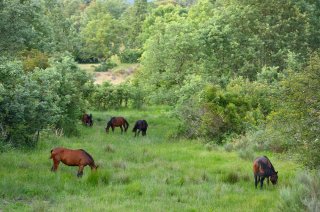
category_news
Large herbivores can reduce fire risks
The use of large herbivores can be an effective means to prevent and mitigate wildfires, especially in places facing land abandonment. They can replace much more costly solutions like firefighting or mechanical vegetation removal. This is the finding of a study led by researchers from the German Centre for Integrative Biodiversity Research (iDiv) and Wageningen University & Research, published in the Journal of Applied Ecology. They provide suggestions for fire and agricultural policies in Europe and globally.
Loss of established firebreaks
In many parts of the world, socio-economic drivers are causing large-scale land abandonment. Nomadic practices and pastoralism are decreasing worldwide as well. As a result, areas gradually grow over with bushes, and trees accumulate combustible plant material. Established firebreaks are lost. These processes lead to a higher risk and greater intensity of wildfires. Currently, one of the main responses to this risk is to invest in firefighting capacity. While this can be effective in fighting wildfires once they occur, more promising strategies involve avoiding intense wildfires in the first place.
Reducing risks
Researchers from the German Centre for Integrative Biodiversity Research (iDiv), Wageningen University & Research, Leipzig University, the Helmholtz Centre for Environmental Research (UFZ) and CIBIO/InBIO – University of Porto and University of Lisbon, in a cooperation project with Rewilding Europe, found that large herbivores – including domestic livestock, wild and semi-wild herbivores – can form a nature-based solution to reduce the risk of wildfires.
The international research team examined whether large herbivores can reduce the amount of fire-prone vegetation and in turn the impact of wildfires. To do this, they evaluated existing studies that investigated connections between herbivores, vegetation structure, fire risk, fire frequency and fire damage. They found that herbivores can mitigate wildfire damage. The effectiveness depends on a number of factors: herbivore population density, herbivore species and diet, but also the type of vegetation and environmental conditions.
Around the world, wildfires are posing major risks to people and nature. Domestic and wild animals can help prevent them.
The role of herbivores
“Not only domestic animals can do the job, but reintroducing wild and semi-wild herbivores can also be effective in reducing wildfire risk, especially in remote and inaccessible areas where careful management with herbivores can combine wildfire prevention with nature conservation,” said Julia Rouet-Leduc, lead author of the study and doctoral researcher at iDiv and Leipzig University. Dr Fons van der Plas, senior author of the study and an assistant professor at Wageningen University added: “Extensive forms of grazing will not lead to homogeneous short vegetation, but the presence of short, grazed patches can already be enough to avoid uncontrollable fire spread, acting as natural fire breaks.” Where needed, short-term intensive grazing (known as “targeted grazing”) can also be combined with other actions like mechanical clearing to further reduce fire risks.
Policy Recommendations
Based on their findings, the researchers make recommendations for land managers and policymakers to mitigate wildfires. One is to maintain and promote extensive grazing by domestic or (semi-)wild herbivores in areas currently facing land abandonment. This will require integrating relevant agricultural, forestry and fire management policies, and providing financial support for fire prevention with animals. In Europe, for example, the Common Agricultural Policy should support farmers and land owners in using extensive grazing for fire management.
“But we have to accept that fires are natural processes and important to many ecosystems, and we have to learn to live with them to a certain extent,” said Rouet-Leduc. “With climate change, wildfires are likely to become increasingly severe in many parts of the world,” adds Pe’er. “Current policies can, and should, take much better account of nature-based solutions, like allowing herbivores to do their job.”
The study was conducted as part of project GrazeLIFE (LIFE-Preparatory project on request of the European Commission) coordinated by Rewilding Europe